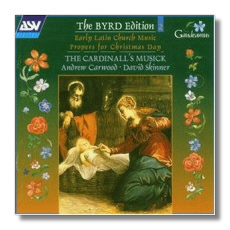
The Internet's Premier Classical Music Source
Related Links
- Byrd Reviews
- Latest Reviews
- More Reviews
-
By Composer
-
Collections
DVD & Blu-ray
Books
Concert Reviews
Articles/Interviews
Software
Audio
Search Amazon
Recommended Links
Site News
 CD Review
CD Review
William Byrd

The Byrd Edition, Volume 7
- Propers for Lady Mass from Christmas to the Purification
- Defecit in dolore
- Domine praestolamur
- O Domine adjuva me
- Tristitia et anxietas
- Memento Domine
- Vide Domine afflictionem
- Deus venerunt gentes
- Domine tu jurasti
The Cardinall's Musick/Andrew Carwood
Academy Sound & Vision Gaudeamus CDGAU224 68:20
Summary for the Busy Executive: Close to ideal.
Even at this late date, composers before, say, Purcell are little-known. The music they wrote sounds strange to us, mainly because in the wake of Bach and Wagner, we've forgotten the emotional key. The Renaissance boasts many fine, even great composers, among the latter William Byrd. As a chorister, I've been singing his music for more than thirty years, and I know only a small fraction of it. Now AS&V's Gaudeamus imprint undertakes what seems a major exploration of Byrd's catalogue. The internet shows me eight recorded volumes so far.
Byrd remained a Catholic in Protestant England, at a time when such affiliation meant danger. Many of his friends went to jail or to the executioner as they became entangled or merely associated with various plots to overthrow or assassinate Queen Elizabeth. Indeed, the authorities once rounded up Byrd himself but let him go, on the grounds that he was "merely a musician." So at times social contempt for the arts does pay. He wrote in many genres, sacred and secular, with eminence in all of them. Unlike his teacher, Thomas Tallis, Byrd kept testing the limits of the regime. Among other things, he wrote (and published!) two complete settings for the Propers (that part of the Catholic liturgy specific to a feast or church season), even though the use of such rites in public worship had been banned. A "lady mass" is one held in honor of Mary and most of the texts praise the Virgin – yet another sign of Byrd's Catholicism. Gaudeamus appears bent on issuing recordings of all the Propers, collected into the Gradualia. I hope they make it to the end. Besides church music with quasi-utilitarian purpose, Byrd also wrote what some call "free motets" – that is, sacred choral works not specific to any Christian rite, Protestant or Catholic. Certain musicologists make much of the fact that the Cantiones Sacrae (three large collections from 1575, 1589, and 1591, respectively) set Latin texts – Latin associated, of course, with Catholicism. I tend to doubt Byrd made that kind of distinction, shown by the fact that he sometimes put English words to motets originally set in Latin and that English Protestant composers continued to mine Latin texts. What points more strongly to Byrd's Catholicism is that many of the texts he chose (or composed) refer to the Babylonian Captivity – the chosen in the midst of the heathen (or heretics).
 |
| Volume 4 Academy Sound & Vision CDGAU178 |
The 1575 collection Byrd made in collaboration with Tallis. This, coincidentally, was the first extended work of Byrd I'd heard, beyond the Masses for 3, 4, and 5 voices – an old L'oiseau-lyre LP set with Michael Howard leading the Cantores in Ecclesia, a gorgeous performance which still holds up aesthetically, if not historically. Gaudeamus publishes Byrd's contributions to the set in Volume 4 (CDGAU178). You can find Tallis's contributions on volume 7 of Tallis's complete works (Signum 29) with the Chapelle du Roi led by Alistair Dixon. At any rate, on the program here we get the first eight motets of the 1589 Cantiones Sacrae. Most of the motets wail by the waters of Babylon or in the land of Egypt. I'd emphasize the word "wail." Of all the Tudor composers, Byrd, Dowland, and Weelkes lie closest to modern sensibilities, mainly because they regard music as a vehicle for immediate drama. A listener doesn't have to know the arcana of Renaissance music aesthetics in order to comprehend the emotional import of the music. You don't have to "think yourself back" with Byrd, as you do to some extent even with such wonderful composers as Sheppard, Taverner, Cornysh, Philips, Dunstable, and Tye.
In "Domine praestolamur adventum tuum" (O Lord, we look for your coming), for example, the rising line of the first idea expresses the anticipation, the longing for God to "dissolve the bonds of our captivity" – the last two words set to the same rising idea. The second half of the motet, beginning at the words "Veni, Domine, noli tardare" (Come, Lord; do not delay), increases the urgency of the request by having the voices enter at closer and closer intervals. A listener might not pick up the mechanics of this but will undoubtedly recognize the emotional rise.
Carwood, a very stylish singer himself, recognizes the drama in the writing and brings forth performances both emotional and impeccable – sort of a vocal analogy of the Quartetto Italiano. The Cardinall's Musick, eleven singers, perform these works one to a part, giving their account an intimacy, the sense of the anguish and hope of one person. Furthermore, each singer shapes the line as a string quartet player would, stepping up and stepping back, depending on the structural prominence of the line at any particular moment, and thus impart a kaleidoscopic shimmer to the music. I've heard no better ensemble singing than this. I could, if I wanted, quibble with the resolutely straight tone of the singers, obviously a deliberate choice of the director. But the singing knocks me out so technically, musically, and emotionally that I'd consider such a complaint ungracious. The acoustic – less resonant than for most recordings of this kind of music – suits the sound.
In short, a major series of releases.
Copyright © 2004, Steve Schwartz


















